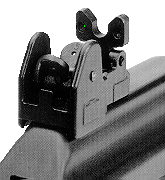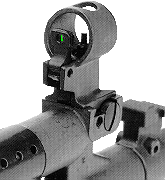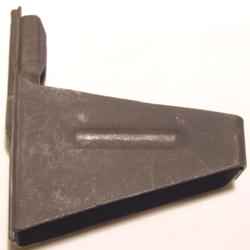

  |
Galil Machine Guns Used by Hungary |

Manufacturer: Israeli Military Industries (IMI), Ramat Ha Sharon, Israel
Caliber: .223 Rem, 35-rnd box magazine
Gas-operated, rotating bolt
Overall Length: 978mm [38.5"], 742mm [29"] with stock folded
Weight unloaded: 4.3kg [9.5lbs]
Barrel 460mm [18.1"] 6-grooves, constant rh twist, 1 turn in 300mm
Rear sight: Flip type aperture, adjustable for elevation
Front sight: Post, adjustable for windage and elevation
It is unknown which Hungarian units (if any) used this Galil model.
 |
Manufacturer: Israel Military Industries (IMI), Ramat Ha Sharon, Israel Caliber: 7.62x51nato, 25-rnd box magazine Gas-operated, rotating bolt Overall Length: 1029mm [40.5"], 792mm [31"] with stock folded Weight unloaded: 4.3kg [9.5lbs] Barrel 508mm [20"] 4-grooves, constant rh twist, 1 turn in 300mm Rear sight: Flip type aperture, adjustable for elevation Front sight: Post, adjustable for windage and elevation |
Use: Hungarian Police forces: special service. In use with TESZ and RKSZ
6x scope. Bipod
The Galil rifle was the result of lessons learned by Israeli desert fighters in the 1967 Six-Day War. Developed by Israel Galili, chief weapons designer
for IMI (Israeli Military Industries), and Yaacov Lior, the Galil is a somewhat successful attempt at 'best of all possible worlds'. Dissatisfied with the
7.62mm NATO FN FAL with which the Israeli Army was largely equipped, as it has always been a poor performer in high sand and dust environments, Galili went
directly into the field to investigate the problem. He was told that the Kalashnikov was the "tiger of the desert." Taking what he needed from the AK-47,
Galili placed his rifle in competition with the M16A1, the Stoner 63, the AK-47, the HK 33 and a design by Uziel Gal. The test's greatest emphasis revolved
around performance under arid-region conditions. The Galil emerged as the clear winner and won the Israeli Defense Award. It was officially adopted by the
Israeli Defense Forces (IDF) in 1972. The Galil rifle as issued to the IDF is chambered for the 5.56mm NATO M193 ball ammunition. For export, it is
available in full auto, semiautomatic and selective-fire versions, and in caliber 7.62mm NATO to increase its sales on the world market.
The Galil's Kalashnikov heritage is apparent, even at first glance. Not so evident are its differences. It fires from the closed-bolt position and is
gas-operated without an adjustable regulator. The change in caliber, from 7.62x39mm to 5.56mm NATO, required numerous alterations. The AK-47's 4.2mm gas
hole was reduced in diameter to 1.8mm. The Galil's most immediate predecessor was the Finnish Valmet M62 rifle and, in fact, early Galil prototypes were
fabricated using M62 receivers made in Helsinki. However, as the 52,000 cup SAAMI (Sporting Arms and Ammunition Manufacturers' Institute) pressure limit
specified for the 5.56mm NATO round is far greater than that developed by the 7.62x39mm cartridge, Galili abandoned the pinned and riveted, stamped
sheet-metal receiver of the Valmet M62/M76 series and went to a heavy milled forging. In addition, the Galil does not utilize the usual Kalashnikov
barrel-extension unit for lock-up of the bolt. The bolt lugs lock into recesses milled into the receiver body itself. Thus, heat dispersion occurs more
rapidly, the cartridge remains cooler and the possibility of a cook-off, even under the most intensive full-auto conditions, is minimized.
While the method of operation is identical to the Kalashnikov, Soviet AK-47 parts most certainly cannot be used in the Galil, contrary to the statements
of others. When the trigger is pulled, the hammer drives the firing pin forward to ignite the primer. Kalashnikovs have inertia firing pins without a
spring. Ammo with soft primer cups may cause slam-fires, so all newer Galils have been fitted with strong firing pin springs. After ignition of the primer,
a portion of the propellent gases migrate into the 1.8mm vent, drilled at a 30-degree angle into the gas block which is pinned to the barrel. The gas enters
the cylinder (to which a small spring has been attached to secure its retention during reassembly) and drives the piston rearward. The piston is
hard-chrome-plated for ease of maintenance. It is also notched to provide a reduced bearing surface and permit excess gas blow-by. The bolt carrier is
attached to the piston. After a short amount of free travel, during which time the gas pressure drops to a safe level, the cam slot engages the bolt's cam
pin and the bolt is rotated and unlocked as the carrier moves rearward.
Primary extraction occurs as the bolt is rotated and thus the massive Kalashnikov-type extractor claw is not required. Empty-case ejection is typically
violent. The cases are severely dented by the ejector and thrown to the right and front by as much as 40 feet (a defect with regard to position disclosure).
At this time, the recoil spring is compressed and its return energy drives the carrier forward to strip a round from the magazine and chamber it. The
Galil's hammer spring is made of multi-strand cable. The trigger and sear springs are conventional coil types. Like other Kalashnikov-system rifles, the
trigger mechanism is that first used in the US M1 Garand rifle.
The Galil's right-side selector lever is the same stamped, sheet-metal bar common to all Kalashnikovs. South African troops often wrap nylon line around
this selector bar to quiet the sound of its manipulation. It can also be slightly bent to draw it away from the receiver notches. The top position, marked
"S," is safe, where the trigger is locked and the bolt can be retracted only far enough to inspect for a chambered round in this position. The Galil also
features a selector switch on the receiver's left side, intended to be manipulated by the thumb of the trigger hand. On the semiauto version, through use of
a two-piece hinged bar inside the receiver, the rearmost position of this selector is safe and pushing forward with the thumb will place the weapon in the
firing mode, marked "F." This is as it should be. However, on the selective-fire model the rearmost position is "R" (British terminology for Repetition, or
semiauto), the middle position is "A" (full auto) and the forward position is safe. Thus, to come off safe, using the left-side selector, one must pull
rearward with the thumb, a most unnatural and awkward manoeuvre, especially under stress. On the selective-fire Galil, two sears control the firing
mechanism, the trigger sear and a safety sear. In full-auto fire the trigger sear is held back and only the first round of the burst is fired off this rear
sear. Subsequently, the bolt carrier moves rearward and rolls the hammer over. The safety sear continues to hold the hammer back until the bolt carrier is
fully forward again, at which time it trips the safety sear and the hammer rotates to fire another round. Thus, after the first round the trigger sear is
deactivated entirely from control on the hammer. Releasing the trigger will catch the hammer on the trigger sear once more. In semiautomatic fire, no
pressure is placed on the trigger sear, which is free to catch the hammer each time it is rolled back by the bolt carrier.
The entire safety sear assembly (sear, spring, cross pin and trip lever) is absent from the semiautomatic-only version of the Galil. In addition, certain
receiver mill cuts have not been made, the hammer spring pin protrudes from the right side of the receiver to stop further downward travel of the selector
lever and the bolt carrier has been altered to prevent full-auto fire. Unauthorized attempts to convert this rifle to selective fire would be most
difficult and quite dangerous.
There are three basic configurations of the Galil, all available in calibers 5.56mm NATO or 7.62mm NATO: The ARM is equipped with a bipod, wooden
handguard and carrying handle. It is intended for use as an assault rifle and squad automatic weapon. The AR is equipped with a high-impact-plastic
handguard without a bipod or carrying handle. The barrel length of both, in caliber 5.56mm NATO, is 18.5" with the flash suppressor (and 21.0" for the
7.62mm NATO models). Both are available in semiauto-only and selective-fire versions. The SAR is a short-barreled version of the AR model. It has a barrel
length of only 13.5" in 5.56mm (15.8" in the 7.62mm version) and, as a consequence, is available in the United States as a selective-fire weapon only.
Its gas tube and piston are 1.12" shorter than the other models. The 5.56mm NATO Galils all have six-groove barrels with a right-hand 1:12" twist for the
M193 ball projectile. All three are normally issued with a folding stock, although a wooden buttstock is an available option.
At first glance, the folding stock appears to be that of the FN FAL. It is not. The FAL stock is constructed of tubular aluminum. The Galil folding stock
is fabricated from tubular steel - stronger, but heavier. More important, the Galil stock has no button latch to confound the operator in opening or
closing, no small consideration during high-stress situations.
The ARM's carrying handle is almost identical to the Belgian FAL'S. Located to the rear of the wooden handguard, it is not positioned over the rifle's
center of mass. The wooden handguard remains somewhat cooler during sustained full-auto fire than the black plastic handguard. The squared-away shape of the
wooden handguard is not entirely comfortable, but necessary to store the bipod. Both the plastic and wooden handguards are attached permanently to the
barrel and cannot be removed.
The Galil bipod is a sturdy, rigid affair, certified so by my memory of Israel Galili jumping wildly and theatrically on top of the rifle with its two
steel legs extended. When stored in the handguard, the bipod serves as a feed chute to speed insertion of the magazines. The bipod can be used as a wire
cutter and to open beer bottles also.
The Galil's gray-plastic pistol grip is one of the very best ever put on an assault rifle and seems to be taken from the Hungarian
AKM/AMD-65 series. Of more than adequate length, with a sharp bottom flare to prevent the hand from slipping, the grip has been mounted to the receiver
at precisely the correct grip-to-frame angle. Somehow, it just feels right.
Galil offers tough, all-steel magazines in three capacities: The 12-round magazine, color-coded with whith stripes, is blocked to accept only ballistite
(blank) cartridges for launching rifle grenades. The standard magazine has a capacity of 35 rounds. A large capacity 50-round is also available. Difficult
to load by hand, it is intended for use primarily in the squad automatic role. However, like all bottom-fed magazines of this length, it will "monopod" the
weapon when fired with the bipod in the prone position. An optional magazine adapter allows the use of 20- and 30-round M16 magazines. Unfortunately, the
magazine wells of the semiautomatic and selective-fire Galils are of different dimensions and the adapter supplied by IMI can be fitted only to the
semiautomatic version. Why this is so I do not know. However, the adapter is well-designed and the magazines can be inserted and released with no greater
difficulty than in the M16. Valmet 5.56mm NATO magazines will likewise fit into the semiautomatic Galil, but cannot be used in the selective-fire rifle.
South African R4 magazines are identical to their Israeli counterparts and can be inserted into all versions of the Galil. The magazine-release latch is of
the flapper type, similar to the Kalashnikov.
The retracting handle is attached to the bolt carrier and bent upright to allow cocking with either hand, providing a useful feature. The flash
suppressor has six ports and is almost identical to the M16 "birdcage" muzzle device. The Galil accepts the readily available M7 bayonet issued for the M16.
The rear end of the Galil's recoil-spring guide rod, which serves as a retainer for the sheet-metal receiver cover, has been extended to ease disassembly
and lock the cover more securely to the receiver body. This is especially important as the rear sight has been mounted on the receiver cover. While no less
secure than its attachment to the gas cylinder on the Valmet M71, it does not provide the rigidity offered by the receiver-mounted rear sight of ComBloc
Kalashnikovs. The trade-off is a longer sight radius.
Reassembly of the receiver cover on all Kalashnikov-type weapons is simplified if you first place the recoil-spring guide rod slightly below its
notch in the receiver onto the rear interior wall of the receiver. Then set the receiver cover in place. Jack the retracting handle smartly to the rear and
the guide rod will pop into its notch and the square-cut hole in the receiver cover. Standard Kalashnikov disassembly and reassembly procedures apply to the
Galil. But, a small, though important, correction to the preventive maintenance instructions given in the IMI operator's manual is required. After cleaning,
we are instructed to lubricate the gas cylinder and piston. I say no to that. Keep lubricants of all types away from the piston and the interior of the gas
system. The intense heat generated in this area of a gas-operated weapon will cause lubricants to bake and varnish these parts.
 |
 |
The rear sight is a flip-up peep type with 300 and 500-meter apertures adjustable for elevation only. The front-post sight is adjustable for elevation and windage zero. Elevation adjustments are by means of the UZI front-sight tool. Windage adjustment is achieved by loosening and tightening the two opposing screws which move the entire front-sight assembly in its dovetail on to the gas block. The diameter of the front-sight hood is such that it forms an additional aiming circle just within the rear aperture to further assist sight alignment and speed target acquisition. Taking another cue from the Valmet, the Galil is equipped with tritium (betalight) night sights set for 100 meters. To use, at dusk or night, the front betalight is folded up to expose a vertical bar, which is aligned between the two rear luminous dots. When the rear tritium sight is flipped up for use, the rear peep sights must be placed in an offset position midway between the two apertures. |
The left side of the receiver is dovetailed for a scope side-mount. Mounting a scope on the receiver body usually results in maximum stability. But the IMI side-mount has exhibited a decided tendency to lose zero after take-down and remounting.
The Galil issue sling is admirable. Constructed of heavy, wide, black webbing with sturdy steel hooks at each end that rotate 360 degrees, it is easily the best assault rifle sling I have ever seen. Designers in the past have often neglected this piece of equipment, yet it is important to those in the field. After phosphating (Parkerizing), all exterior metal surfaces on the rifle (except for the barrel, gas block and front sight) are finished with semi-gloss black enamel.
In addition to high marks for hit probability and target acquisition, the SAR exhibited phenomenal controllability in the full-auto mode. The cyclic rate is 650 rpm. Muzzle rise is barely perceptible with two- and three-round bursts. In fact, firing in the off-hand position, at 30 meters an entire and continuous 50-round burst can be contained within a standard military silhouette target! Felt recoil was virtually nonexistent with both rifles. But, a heavy price must be paid for all these attributes.
All of the above operating characteristics are a function of the weapon's weight. At almost 9.5 pounds, empty, with bipod and carrying handle, the ARM is quite heavy in comparison with other state-of-the-art assault rifles. The M16 and AKM weigh only 7.0 pounds apiece. The Galil is only a quarter-pound shy of the U.S. M14. So what, you say? The South African troops who must constantly drag this beast through the bush have real cause for complaint. The Galil's weight is principally a consequence of the designer's attempt to create a weapon system which could serve the roles of submachine gun, infantry rifle and light machine gun. To date no other short-barreled assault rifle comes closer to stealing the submachine gun's final fading thunder than the SAR. With its stock folded, it measures only 24.5" in length. Most modern submachine guns fall somewhere between the 16.4" Beretta M12S and the 19.3" HK MP5A3. Presenting a package in size close to the SMG, the SAR chambers a cartridge far more potent at much greater ranges than the 9mm Parabellum. As an assault rifle, the sturdy and reliable Galil is one of the very best.
It is in the role of a squad automatic weapon that it falls short of the mark. By definition of its requirement for intensive sustained fire at the squad level, the ideal SAW should incorporate a quick-change barrel, adjustable gas regulator and belt-feed potential. The Galil has none of these features; the US M249 has all of them. And, as I mentioned previously, the tendency of the 50-round magazine to "monopod" the weapon when fired off the bipod in the prone position seriously compromises the Galil's ability to effectively engage targets at any small degree of elevation above the operator.
In general, the Galil system is well-executed, and a fine example of the qualities one should look for in a modern assault rifle. It stands as testimony to the brilliance of Israel Galili as a military small-arms designer and is, without doubt, his crowning achievement to date. That it is not perfect is simply an axiom which has held since the invention of gunpowder and will lead to the continued evolution of military small arms. The Galil's important position in the history of such matters is secure.
 Galil Magazine loader device
Galil Magazine loader device